Edible Culture: Ten Creole Specialties
to Try in Martinique
Article and photos by Darrin DuFord
Published 5/25/2015

|
|
Langouste grillée at
Le Littoral.
|
As a sea-bound corner of France in the
Caribbean, Martinique reflects its geography and its fusion
of historical influences, most notably in its Creole cuisine.
French and Native American culinary techniques meet African
and Caribbean ingredients as well as South Asian spices
on this island where even her most famous musical export,
the band Kassav, took its name from the Creole word for
cassava, one of the accompanying staples of Martinican meals.
Here are some Creole dishes you will
encounter in Martinique at eateries that range in ambience
from roadside barbecues to air-conditioned brasseries.
Boudin Créole (blood
sausage)
A mainstay of the Creole appetizer menu,
the boudin créole,
also called boudin noir, is a blood sausage without
any hint of bloody flavor. The pork blood is mixed with
pork fat, bread crumbs, and spices such as cloves, allspice,
and hot pepper powder before being stuffed in casings and
lightly boiled in water seasoned with chives.
The filling is soft and spreadable,
so after poking a hole in the end of the boudin casing,
the filling can be squeezed onto bread or toast. The restaurant
Barracuda, an open-air eatery on the beach of Anse Mitan,
makes a smooth boudin créole ready for spreading
onto slices of a fresh baguette. Typically, 5 to 8 euros
will buy you a trio of boudins for a substantial appetizer.
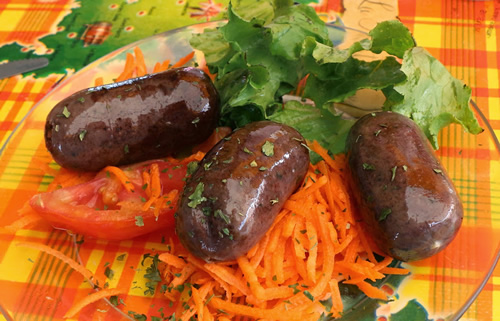
|
|
Boudin creole at Restaurant
Barracuda.
|
Crabes Farcis (stuffed
crab)
The crabe farci is often served
in a reusable plastic shell that could be mistaken for a
child’s toy, complete with beady, painted eyes. A
squirt from a wedge of lime adds a fruity acid note that
cuts across the pleasantly heavy mixture of milk, lard,
breadcrumbs, hot pepper, green onions, and crab meat. The
hot peppers are employed to gently warm the palate, and
thus do not overpower any of the other flavors.
Expect to spend 8 to 12 euros per pair,
not counting the cost of bringing home the plastic shells
if the restaurant allows you to purchase them.
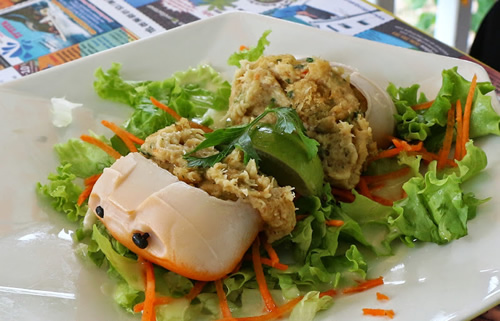
|
|
Crabes farcis at Le
Littoral.
|
Accras de Morue (cod fritters)
Accras de morue don’t
have the familiar flaky texture of cod because the meat
is minced before mixed with green onions and hot pepper.
Like all fried food, accras de morue should be
fried to order, as is done at the café stalls at
the west end of Fort-de-France’s 113-year old covered
spice market, a wonderland for foodies. I found that a browse
through the market’s tables of muscade (nutmeg), graines
de bois d’inde (allspice berries), a variety
of peppers, and other seasonings of Martinican cuisine — as
well as rows and rows of fresh produce such as papayas and christophines (wrinkly
gourds also known as chayotes) — would amply
prime my appetite, so there is no wonder that the café chefs
chose to set up shop at such a strategic location.
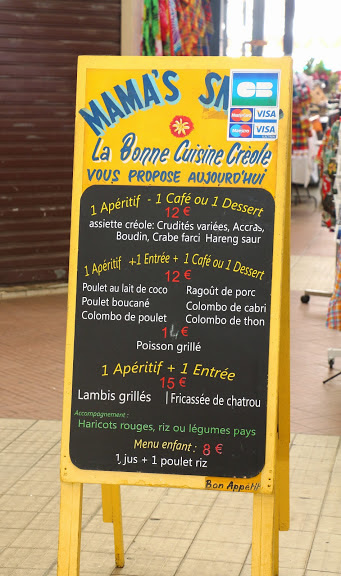
|
|
The menu for Mama's Snack, a
lunch kiosk inside Fort-de-France's spice market.
|
A plate of three or four accras,
garnished with carrot and lettuce, should cost no more than
5 to 7 euros.
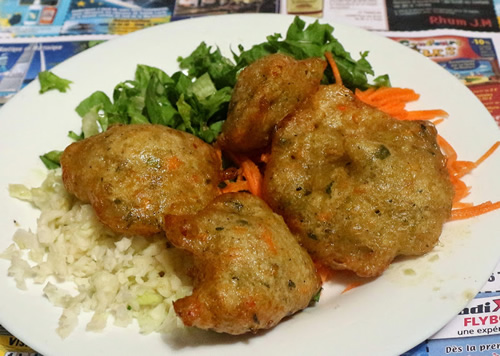
|
|
Accras de morue at Mama's
Snack in the spice market of Fort-de-France.
|
Langouste Grillée (grilled
lobster)
The lobster species patrolling the bottom
of Martinique’s waters and the rest of the Caribbean
is the spiny lobster, a crustacean that lacks the hulky
front claws of its cousin from Maine and Canada’s
maritime provinces. The bases of the spiny lobster’s
antennae, however, reveal small caches of sweet knuckle
meat. The spiny lobster is often split in half, grilled,
and topped with sauce chien — literally dog
sauce, a chunky condiment whose ingredients include chives,
onions, peppers and lime juice, but none of man’s
best friend.
The restaurant Le Littoral, overlooking
the waterfront of Anse D’arlet, does a brisk business
in langoustes grillées at 25 euros for half
a lobster served with sides of calabaza squash, cassava,
and rice.
Lambi (conch)
Lambi is one of Martinique’s
most flexible ingredients. It stars in ravioli and in fricassees,
and it even turns up in crêpes. This marine gastropod
resembles octopus in texture and flavor, and it takes well
to Martinique’s thick, citrusy, tomato-based fricassee,
especially when richened with a dollop of crème
fraîche. Le Moulin à Cannes, the restaurant
at the Depaz rum distillery, serves a tender conch fricassee that
is best enjoyed while taking in the view of the Caribbean
Sea from the dining room’s open-air vantage point
at the base of Mount Pelée. Expect to pay around
22 euros for a lambi-based entrée.
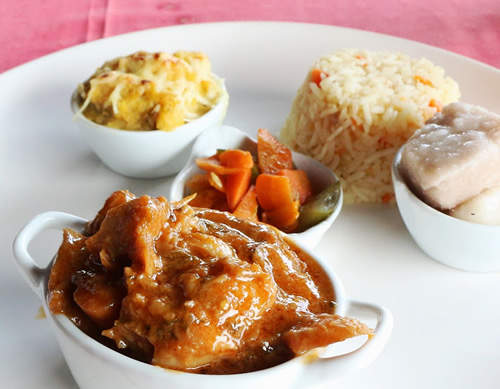
|
|
Conch fricassee at Le
Moulin à Cannes.
|
Ouassou (freshwater crayfish)
While a native species of ouassou can
still be found at seafood markets, the most common species
gracing dinner plates was introduced to the island in 1974.
Originally from the Indo-Pacific region, the latter ouassou
has thinner, longer front claws and a fat, buttery-sweet
tail.
The Café Dubuc, on the Caravelle
Peninsula, serves ouassou fricassee, which doubles
as an accompaniment to the three-piece house band playing
jazzy versions of Martinique’s mazurkas and biguines
on the patio dining room on Sunday nights. Typically, 25
to 30 euros will score you three or four ouassous per order.
Don’t forget to suck the heads.
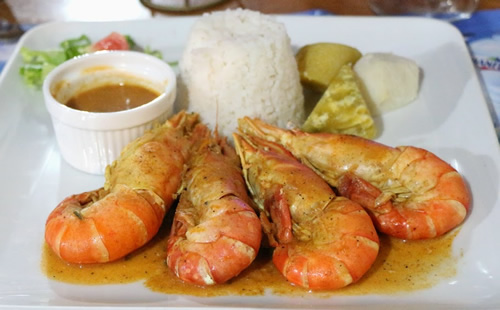
|
|
Ouassou fricasee at
Café Dubuc.
|
Poulet boucané (Martinican
barbecued chicken)
The gastronomic odyssey that is poulet
boucané successfully rescues chicken from
the boringly safe dinner category and elevates it to
a memorable experience. The grill chef first marinates
on-the-bone chicken in lemon or lime juice, garlic, and
shallots for several hours, or even overnight; only then
does the chicken meet the fire of the barbecue. Finally,
the chef tops the crisped-up skin of poulet boucané with
sauce chien.
Poulet boucané may very
well be Martinique’s answer to Texas’ barbecue
tradition. Or, it could be the other way around. Let us
not forget that the word "barbecue" is believed
to have originated from a word in the language of the Taíno,
an indigenous Caribbean nation, that referred to the technique
of cooking meat on a rack over hot coals.
Poulet boucané can be
found at barbecue stands on the beach, roadside barbecues,
or waterfront restaurants. The café stalls in the
Fort-de-France spice market offer specials, like a combination
of accras de morue, poulet boucané, and
a coffee for 12 euros. By itself, the dish may cost from
10 to 14 euros, depending on whether a takeout or sit-down
restaurant is chosen.
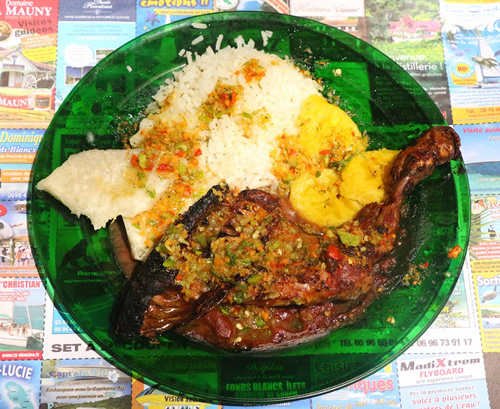
|
|
Poulet boucané at Mama's
Snack at the spice market in Fort-de-France.
|
Colombo Dishes
When France abolished slavery in 1848,
Tamil laborers began arriving in Martinique and other French
Caribbean islands, and the laborers brought their curry
with them. The islands adopted and adapted the spice blend
and named it Colombo, after the city of Sri Lanka from where
many of the laborers traveled. Mild when compared to most
curry spice blends from the Indian subcontinent, Colombo
flavors fish, chicken, goat, and pork in Martinique, usually
in an aromatic stew containing julienned carrots, mangos,
and coconut milk.
L'embarcadère, a marina-side
restaurant in Pointe du Bout, serves a satisfying on-the-bone
chicken colombo; in Sainte Anne, the restaurant Le Rendez-Vous
serves a tender fish colombo on its covered patio that looks
out onto the Caribbean Sea. Colombo dishes usually run between
10 and 14 euros; fish may cost a euro or two extra.
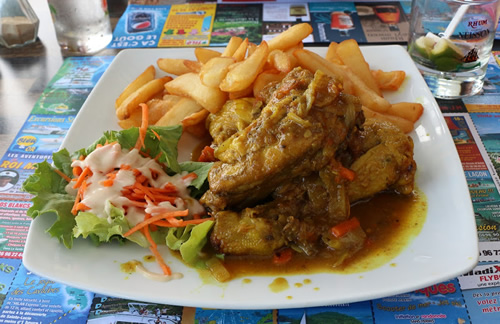
|
|
Colombo de poulet at
L'embarcadère.
|
Rhum Agricole
Almost every island in the Caribbean
distills rum, but Martinique’s rhum agricole stands
out because Martinique’s distilleries utilize fresh
cane juice, not the leftovers from the sugar-making process.
Such attention and expense instill the rum with a pronounced
aroma of sweet, fresh cane. Tasting rooms at the distilleries
are great ways to sample the company’s offerings as
well as a fun way to learn about rum making. The distillery
of St. James, near the town of Trinite, welcomes visitors
with a rum museum, while the Depaz distillery allows visitors
to walk on a self-guided tour around the facility’s
grounds and distilling equipment. Travelers to the Caravelle Peninsula can visit the tasting room of the Hardy distillery and meet the seventh generation owner.
Rhum Agricole is the main ingredient
in the iconic ti-punch (from the French word petit,
or “little,” although there’s nothing
little about the drink’s strength). Made from Martinican rum, fresh lime and island sugar, the drink runs around
5 euros and may be served with a glass of sugar and a spoon
beside the neat rum, or sugar may already be added in.
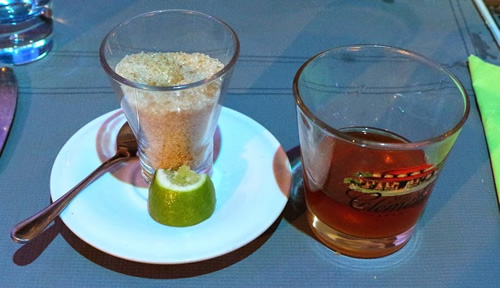
|
|
A ti-punch at Le Foyaal,
Fort-de-France. The imbiber adds sugar and lime juice
to taste.
|
Curry Terrine
The terrine — France’s
chunky, meaty spread held together with pork fat — enjoys
a loyal following in Martinique. A variety of brands, shipped
over from mainland France, are available in the supermarkets.
But on the shelf next to the Parisian offerings, the terrine connoisseur
can find a few locally made brands that Martinicans have
Creolized with spice blends such as curry.
Terrines do not require refrigeration
until after they are opened, so they are ideal for a picnic
on the beach with a fresh, warm baguette from one of Martinique’s
ubiquitous boulangeries. Grocery stores throughout
the island, as well as Fort-de-France’s outpost of
Carrefour — sell terrines. A brightly-lit grocery store
chain where Martinicans stock up on every day groceries,
Carrefour might not be a place the guidebooks recommend, but it is worth a visit just to people-watch and
shop side-by-side with the Martincans for whatever humble
shelf-stable eats they prefer (Carrefour also sells freshly
baked baguettes in the morning — you can’t miss
the scent when you walk in, as the stack is by the entrance).
A jar rarely runs more than 6 euros
and is one of the easiest and most inexpensive ways to simultaneously
explore the multiple facets of Martinique’s culinary
terrain with your tongue.
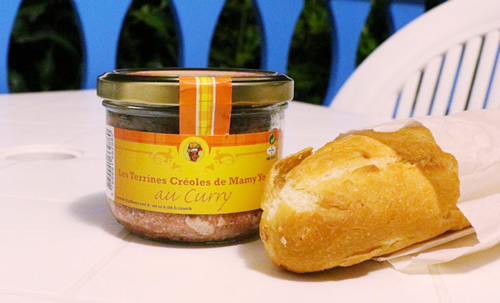
|
|
Curry terrine.
|
Darrin DuFord is
a travel writer, mapgazer, and jungle rodent connoisseur.
A past narrative
travel writing contest winner with Transitions Abroad,
he has also written food and travel articles for The
San Francisco Chronicle, BBC Travel, Gastronomica, and
Perceptive Travel, among other publications. He is the
author of "Is
There a Hole in the Boat?" "Tales of Travel in Panama
without a Car," and silver medalist in the 2007 Lowell
Thomas Travel Journalism Awards. Read his latest ruminations
on travel and food on his blog, OmnivorousTraveler.wordpress.com, where you can also see his many publications, with the most recent being "Breakfast for Alligators," which we strongly recommend.

|
